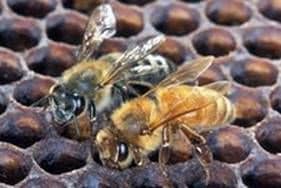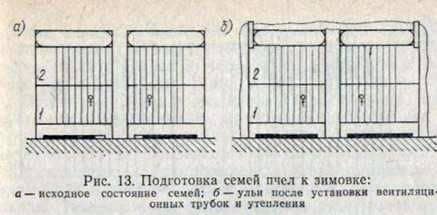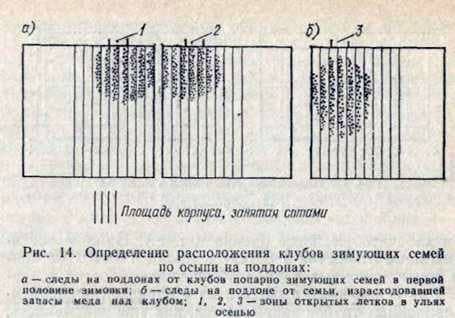
The work is carried out when frosty weather sets in – November – early December. External tapholes are filled with a heater and tightly closed by gate valves, and internal ventilation openings are opened in the pallet bar. The hive provides a reliable (without drafts from the club) vertical ventilation. For this purpose, ventilation tubes are inserted into the holes of the ceiling, and the ceiling is installed so that the holes are out of the formed club.
The moss cushion is laid in the pod. The walls of the hulls and the top of the hives are covered with a suitable material (batting in two layers, old cotton or cotton blankets, etc.). The lower ventilation openings in the pallet bar and the open ends of the ventilation pipes ensure air access. To prevent the bees from reaching the pavilion, the ends of the ventilation tubes are closed, with lids from household plastic containers or tied with gauze in one layer. Roofs do not set.

Thus, in winter, the hives have a thermal insulation consisting of flaps from the wall of the hive housing, an air gap (20 mm) between the hull and the pavilion wall. The outer side walls of the outer hives form a single whole with soft insulation, laid between the hive and the wall of the pavilion.
The upper insulation consists of: from the ceiling, 150-200 mm moss pillows embedded in the overburden, a common thermal insulation of all hives, covering the cracks between the hives and the walls of the pavilion. Mosquito cushions are additionally laid on the gaps between the hives, and the rear walls of the hives are covered with a total of two-three layers of wadding insulation.
With such warming and ventilation, the temperature in the hive outside the club in winter is set at 5-6 њ C higher than in the pavilion. The closer the temperature in the pavilion to 8-9 њ C, optimal for the wintering of bees, the less this difference.
During thaws, when the temperature in the pavilion with heating rises to 6-7 њ C, in the hive, it exceeds the named one by only 1-2 њ C. This confirms the fact of the minimum energy release of the club of bees at a temperature of about 8-9 њ C.
The effectiveness of the recommended warming of the hives is also evidenced by the low power of the heaters.
Using a heater located in a pallet (power – 4 W), increased the temperature in the hive (if heat insulation and ventilation is provided) by 5-6 њ C, and at a heater power of 15 W – by 20 C compared to hives without heating.

Calculations show that the thermal insulation of a wooden shell 20 mm thick and covered with batting in two or three layers is equivalent to thermal insulation of a wooden shell with a wall thickness of 100-120 mm.
With automatic temperature control in the pavilion within 5-8 њ C, additional warming of the hives can be avoided.
Rodents can enter the pavilion. Then, from the end of August, when mice begin to look for winter shelters, it is necessary to regularly destroy them, preventing them from staying in the pavilion.
Prepared in this way for the wintering bees do not require any care until mid-March. It is necessary only once a month to carefully remove the pallets and wax crumbs, other waste from the wintering club to check the state of the family, and if necessary, to help her.
The garbage in the front third part of the hive under 7-8 frames with the presence of only wax crumbs in the waste testifies that a strong family is wintering over the club which has food.
Sugar crystals – a signal about the sweetening of honey. If the sugar is not enough, the crystallization is weak and the bees can not be helped. When the crystals make up the bulk of the waste on the pallet, the bees urgently need water.
The presence of individual stains of diarrhea until February should alert the beekeeper, and if at subsequent inspections their number increases, then the feed is of poor quality. In this case, it is necessary to feed the sugar test (candy) or in the form of a thick sugar syrup (2: 1) in a liter jar tied with two layers of gauze.
Contrary to the existing opinion about the inadmissibility of feeding families in winter with liquid syrup due to possible excitement, the author, having checked the recommendations, became convinced that bees quickly (2-3 days) take such syrup and calm down. And when feeding sugar test, bees are excited, although less, for the whole period of kandi consumption. In a month, feeding should be repeated.
Additional feeding of candy bees or syrup is also necessary when honey is sour from excess moisture in the hive, as seen by drops of honey on the pallet. Hence, it is necessary to strengthen ventilation.
If the traces of garbage falling under the club move along the frames and reach the middle of the hive, we can conclude that the family rose to the ceiling, consuming the reserves of honey over the club, and began to move horizontally. Happen this in March – not scary. Honey enough for the family before flying around and developing reserves on the lateral framework. But if the family went to the ceiling in January or the first half of February, it may require feeding.
To avoid accidents at the end of wintering, it is recommended to give 1-1.5 kg of candy to all families in February. Nevertheless, the decision on winter feeding of bees should be taken, consistent with the need. It can be allowed only to save the family from death, since in all other cases it worsens the wintering conditions. If the bees are prepared for winter using the recommended technology, there is no need for winter feeding.
Слабая пчелиная семья весной. Торт медовый с молоком.
Contents of bees in the pavilion